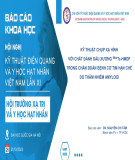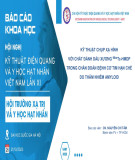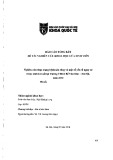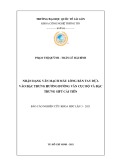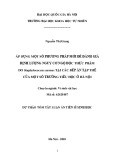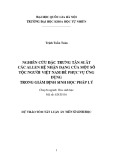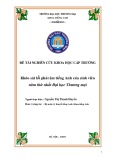
BioMed Central
Page 1 of 13
(page number not for citation purposes)
Journal of Translational Medicine
Open Access
Research
Species distribution and antimicrobial susceptibility of
gram-negative aerobic bacteria in hospitalized cancer patients
Hossam M Ashour*1 and Amany El-Sharif2
Address: 1Department of Microbiology and Immunology, Faculty of Pharmacy, Cairo University, Cairo, Egypt and 2Department of Microbiology
and Immunology, Faculty of Pharmacy, Al-Azhar University, Cairo, Egypt
Email: Hossam M Ashour* - hossamking@mailcity.com; Amany El-Sharif - amanyelsharif@yahoo.com
* Corresponding author
Abstract
Background: Nosocomial infections pose significant threats to hospitalized patients, especially the
immunocompromised ones, such as cancer patients.
Methods: This study examined the microbial spectrum of gram-negative bacteria in various
infection sites in patients with leukemia and solid tumors. The antimicrobial resistance patterns of
the isolated bacteria were studied.
Results: The most frequently isolated gram-negative bacteria were Klebsiella pneumonia (31.2%)
followed by Escherichia coli (22.2%). We report the isolation and identification of a number of less-
frequent gram negative bacteria (Chromobacterium violacum, Burkholderia cepacia, Kluyvera ascorbata,
Stenotrophomonas maltophilia, Yersinia pseudotuberculosis, and Salmonella arizona). Most of the gram-
negative isolates from Respiratory Tract Infections (RTI), Gastro-intestinal Tract Infections (GITI),
Urinary Tract Infections (UTI), and Bloodstream Infections (BSI) were obtained from leukemic
patients. All gram-negative isolates from Skin Infections (SI) were obtained from solid-tumor
patients. In both leukemic and solid-tumor patients, gram-negative bacteria causing UTI were
mainly Escherichia coli and Klebsiella pneumoniae, while gram-negative bacteria causing RTI were
mainly Klebsiella pneumoniae. Escherichia coli was the main gram-negative pathogen causing BSI in
solid-tumor patients and GITI in leukemic patients. Isolates of Escherichia coli, Klebsiella, Enterobacter,
Pseudomonas, and Acinetobacter species were resistant to most antibiotics tested. There was
significant imipenem -resistance in Acinetobacter (40.9%), Pseudomonas (40%), and Enterobacter
(22.2%) species, and noticeable imipinem-resistance in Klebsiella (13.9%) and Escherichia coli (8%).
Conclusion: This is the first study to report the evolution of imipenem-resistant gram-negative
strains in Egypt. Mortality rates were higher in cancer patients with nosocomial Pseudomonas
infections than any other bacterial infections. Policies restricting antibiotic consumption should be
implemented to avoid the evolution of newer generations of antibiotic resistant-pathogens.
Background
Hospital-acquired (nosocomial) infections pose signifi-
cant threats to hospitalized patients, especially the immu-
nocompromised ones [1]. They also cost the hospital
managements significant financial burdens [1,2]. Cancer
patients are particularly prone to nosocomial infections.
This can be due to the negative effect of chemotherapy
and other treatment practices on their immune system [3].
Published: 19 February 2009
Journal of Translational Medicine 2009, 7:14 doi:10.1186/1479-5876-7-14
Received: 21 January 2009
Accepted: 19 February 2009
This article is available from: http://www.translational-medicine.com/content/7/1/14
© 2009 Ashour and El-Sharif; licensee BioMed Central Ltd.
This is an Open Access article distributed under the terms of the Creative Commons Attribution License (http://creativecommons.org/licenses/by/2.0),
which permits unrestricted use, distribution, and reproduction in any medium, provided the original work is properly cited.

Journal of Translational Medicine 2009, 7:14 http://www.translational-medicine.com/content/7/1/14
Page 2 of 13
(page number not for citation purposes)
Most of the previous studies with cancer patients have
only focused on bloodstream infections. However, lim-
ited information is available regarding the spectrum and
microbiology of these infections in sites other than the
bloodstream, such as the urinary tract, respiratory tract,
gastro-intestinal tract, and the skin. This is despite the fact
that these infections are not rare.
Our group has previously studied the microbial spectrum
and antibiotic resistance patterns of gram-positive bacte-
ria in cancer patients [4]. In the present study, the micro-
bial spectrum of gram-negative bacteria isolated from
various infection sites in hospitalized cancer patients was
examined. The spectrum studied was not limited to the
most common gram-negative bacteria, but included less-
frequent gram negative bacteria as well. Both patients with
hematologic malignancies (leukemic patients) and
patients with solid tumors were included in the study.
Thus, the resistance profile of the isolated gram-negative
bacteria was examined. In addition, we detected mortality
rates attributed to nosocomial infections caused by gram-
negative isolates.
Materials and methods
Patient specimens
Non-duplicate clinical specimens from urine, pus, blood,
sputum, chest tube, Broncho-Alveolar Lavage (BAL),
throat swabs, and skin infection (SI) swabs were collected
from patients at the National Cancer Institute (NCI),
Cairo, Egypt. The SI swabs were obtained from cellulitis,
wound infections, and perirectal infections. For each spec-
imen type, only non-duplicate isolates were taken into
consideration (the first isolate per species per patient).
Data collected on each patient consisted of demographic
data including age, sex, admission date, hospitalization
duration, ward, and sites of positive culture. Selection cri-
teria included those patients who had no evidence of
infection on admission, but developed signs of infection
after, at least, two days of hospitalization. Ethical
approval to perform the study was obtained from the
Egyptian Ministry of Health and Population. All the
included patients consented to the collection of speci-
mens from them before the study was initiated.
Microbial identification
Gram-negative bacteria were identified using standard
biochemical tests. We also used a Microscan Negative
Identification panel Type 2 (NEG ID Type 2) (Dade
Behring, West Sacramento, USA) to confirm the identifi-
cation of gram-negative facultative bacilli. PID is an in
vitro diagnostic product that uses fluorescence technology
to detect bacterial growth or metabolic activity and thus
can automatically identify gram-negative facultative
bacilli to species level. The system is based on reactions
obtained with 34 pre-dosed dried substrates which are
incorporated into the test media in order to determine
bacterial activity. The panel was reconstituted using a
prompt inoculation system.
Biochemical tests
In each Microscan NEG ID Type 2 kit, several biochemical
tests were performed. These included carbohydrate fer-
mentation tests, carbon utilization tests, and specific tests
such as Voges Proskauer (VP), Nitrate reduction (NIT),
Indole test, Esculine hydrolysis, Urease test, Hydrogen
Sulphide production test, Tryptophan deaminase test,
Oxidation-Fermentation test, and Oxidase test.
Reagents
For the Microscan NEG ID Type 2 kit, reagents used were
B1010-45A reagent (0.5% N, N-dimethyl-1-naphthyl-
amine), B1015-44 reagent (Sulfanilic acid), B1010-48A
reagent (10% ferric chloride), B1010-93 A reagent (40%
Potassium hydroxide), B1010-42A reagent (5% α-naph-
thol), and B1010-41A reagent (Kovac's reagent).
Antimicrobial susceptibility testing
Both automated and manual methods were used to detect
antimicrobial susceptibility pattern of the isolates. The
Microscan Negative Break Point combo panel type 12
(NBPC 12) automated system was used for antimicrobial
susceptibility testing of gram-negative isolates. A prompt
inoculation system was used to inoculate the panels. Incu-
bation and reading of the panels were performed in the
Microscan Walk away System. Kirby-Bauer technique
(disc diffusion method) was also used to confirm resistant
gram-negative isolates. Discs of several antimicrobial
disks (Oxoid ltd., Basin Stoke, Hants, England) were
placed on the surface of Muller Hinton agar plates fol-
lowed by incubation at 35°C. Reading of the plates was
carried out after 24 h using transmitted light by looking
carefully for any growth within the zone of inhibition.
Appropriate control strains were used to ensure the valid-
ity of the results. Susceptibility patterns were noted.
Calculation of mortality rate
We only calculated attributable mortality which we
defined as death within the hospital (or 28 days following
discharge) [5,6], with signs or symptoms of acute infec-
tion (septic shock, multi-organ failure). Other deaths were
considered deaths due to the underlying cancer and were
excluded from calculations. In addition, patients with pol-
ymicrobial infections were excluded from the mortality
rate calculation.
Results
The main isolated gram-negative bacteria from all clinical
specimens were Klebsiella pneumonia (31.2%; 241 out of
772 total gram-negative isolates) followed by Escherichia
coli (22.2%). Klebsiella pneumonia was the main isolated

Journal of Translational Medicine 2009, 7:14 http://www.translational-medicine.com/content/7/1/14
Page 3 of 13
(page number not for citation purposes)
Table 1: The microbial spectrum of gram-negative bacteria in different clinical specimens.
Different
species
Throat
swab
No(%)
Sputum
No(%)
Chest
tube
No(%)
BAL
No(%)
Pus
No(%)
Urine
No(%)
Stool
No(%)
Blood
No(%)
Total
No(%)
Acinetobacter
haemolyticus
14(18.9) 12(6) 3(30) - 9(4.9) 4(4.1) 1(0.7) 6(10) 49(6.4)
Acinetobacter
lwofii
1(1.4) 3(1.5) - - - - - - 4(0.5)
Acinetobacter
species
(Total)
15(20.3) 15(7.5) 3(30) - 9(4.9) 4(4.1) 1(0.7) 6(10) 53(6.9)
Citrobacter
amaloniticus
- - - - 1(0.5) - - - 1(0.1)
Citrobacter
freundi
- 3(1.5) - - 6(3.2) 5(5.1) 6(4.2) 6(10) 26(3.4)
Citrobacter
species
(Total)
- 3(1.5) - - 7(3.8) 5(5.1) 6(4.2) 6(10) 27(3.5)
Enterobacter
aerogenes
2(2.7) 5(2.5) 1(10) - 10(5.4) 2(2) 13(9.1) 2(3.3) 35(4.5)
Enterobacter
agglomerulan
ce
- - - - 1(0.5) - 2(1.4) 1(1.7) 4(0.5)
Enterobacter
cloacae
6(8.1) 22(11) - - 5(2.7) 2(2) 7(4.9) 2(3.3) 44(5.7)
Enterobacter
gergovia
- - - - 1(0.5) - 1(0.7) - 2(0.3)
Enterobacter
species
(Total)
8(10.8) 27(13.4) 1(10) - 17(9.2) 4(4.1) 23(16.1) 5(8.3) 85(11)
Escherichia
coli
7(9.5) 17(8.5) - - 41(22.2) 37(37.8) 52(36.4) 17(28.3) 171(22.2)
Klebsiella
ornithinolytic
a
- - - - 3(1.6) 2(2) 9(6.3) 1(1.7) 15(1.9)
Klebsiella
oxytoca
- 1(0.5) - - 1(0.5) - 3(2.1) - 5(1.9)
Klebsiella
ozanae
- 1(0.5) - - 2(1.1) - 2(1.4) - 5(1.9)
Klebsiella
pneumonia
29(39.2) 101(50.3) 1(10) - 47(25.4) 31(31.6) 25(17.5) 7(11.7) 241(31.2)
Klebsiella
rhinosclerom
a
- 3(1.5) - - - - - - 3(0.4)

Journal of Translational Medicine 2009, 7:14 http://www.translational-medicine.com/content/7/1/14
Page 4 of 13
(page number not for citation purposes)
gram-negative bacteria from sputum and throat (50.3%
and 39.2% respectively) (Table 1). The main isolated
gram-negative bacteria from blood were Escherichia coli
(28.3%) and Pseudomonas species (16.7%). There was a
significant proportion of cancer patients who developed
SI. The most frequent gram-negative bacteria isolated
from SI were Klebsiella pneumonia (25.4%), Escherichia coli
(22.2%), and Pseudomonas aeruginosa (18.9%). The most
commonly isolated gram-negative pathogens from urine
and stool were Escherichia coli (37.8% and 36.4% respec-
tively) and Klebsiella pneumonia (31.6% and 17.5% respec-
tively) (Table 1).
A number of less-frequent gram negative bacteria were
isolated and identified (Chromobacterium violacum, Bur-
kholderia cepacia, Kluyvera ascorbata, Stenotrophomonas mal-
tophilia, Yersinia pseudotuberculosis, and Salmonella
arizona). In addition, there was a low frequency of enteric
infections as evidenced by the low prevalence of Salmo-
nella, Shigella, and Yersinia species (Table 2).
Klebsiella
species
(Total)
29(39.2) 106(52.7) 1(10) - 53(28.7) 33(33.7) 39(27.3) 8(13.3) 269(34.8)
Pseudomonas
aeruginosa
5(6.8) 10(5) - - 35(18.9) 7(7.1) - 8(13.3) 65(8.4)
Pseudomonas
flourescence
- 1(0.5) - - 3(1.6) - - 2(3.3) 6(0.8)
Pseudomonas
oryzihabitant
- - - - - - 3(2.1) - 3(0.4)
Pseudomonas
stutzeri
1(1.4) 3(1.5) 1(10) - - - - - 5(0.6)
Pseudomonas
species
(Total)
6(8.1) 14(7) 1(10) - 38(20.5) 7(7.1) 3(2.1) 10(16.7) 79(10.2)
Serratia
fonticola
1(1.4) 2(1) - - 2(1.1) 1(1) 4(2.8) - 10(1.3)
Serratia
liquificans
2(2.7) 1(0.5) - - - - - - 3(0.4)
Serratia
marcescens
- - - - 2(1.1) - - - 2(0.3)
Serratia
odorifera
- - - - 1(0.5) 2(2) 2(1.4) - 5(0.7)
Serratia
plymuthica
1(1.4) - - - - - - - 1(0.1)
Serratia
rubidae
2(2.7) 2(1) - - - - - - 4(0.5)
Serratia
species
(Total)
6(8.1) 5(2.5) - - 5(2.7) 3(3.1) 6(4.2) - 25(3.2)
Other gram-
negative
species
3(4.1) 14(7) 4(40) 1(100) 15(8.1) 5(5.1) 13(9.1) 8(13.3) 63(8.2)
Total gram-
negative
species
74(9.6) 201(26) 10(1.3) 1(0.1) 185(24) 98(12.7) 143(18.5) 60(7.8) 772(100)
Table 1: The microbial spectrum of gram-negative bacteria in different clinical specimens. (Continued)

Journal of Translational Medicine 2009, 7:14 http://www.translational-medicine.com/content/7/1/14
Page 5 of 13
(page number not for citation purposes)
Table 2: The microbial spectrum of less frequent gram-negative bacteria in different clinical specimens.
Different species Throat swab Sputum Chest tube BAL Pus Urine Stool Blood Total No(%)
Aeromonas hydrophila - - - - 1 - - - 1(1.6)
Alcaligenes xylosoxidans - - - - 1 1 - - 2(3.2)
Bordetella bronchiseptica - 1 - - - - - - 1(1.6)
Burkholderia cepacia 1 2 - 1 2 - - - 6(9.5)
CDC gp IV C-2 - - - - 1 - - 1 2(3.2)
Cedecea lapagei ---- --11(1.6)
Chryseobacterium indologenes 1------1(1.6)
Chryseobacterium meningosepticum - - 1 - 1 - 1 - 3(4.8)
Chromobacterium violacum 1 1 - - 4 1 - - 7(11.1)
Hafnia alvei - - - - 1 - 1 - 2(3.2)
Kluyvera ascorbata - 2 - - - - 3 - 5(7.9)
Morganella morgani - 2 - - - 1 - - 3(4.8)
Proteus mirabilis - - - - 1 - - - 1(1.6)
Proteus penneri - - - - - - - 2 2(3.2)
Proteus vulgaris - - - - 1 - - - 1(1.6)
Providencia rettgeri - - - - - 1 - - 1(1.6)
Providencia stuarti - - - - 1 - - - 1(1.6)
Salmonella arizona - - - - - - 2 1 3(4.8)
Salmonella choleraesuis - - - - - - 1 - 1(1.6)
Salmonella Paratyphi A - - - - - - 1 - 1(1.6)
Shigella species - - - - - - 4 - 4(6.4)
Stenotrophomonas maltophilia 1 3 1 - - - - - 5(7.9)
Vibrio alginolyticus - 1 - - - - - - 1(1.6)
Vibrio fluvialis - - 1 - - - - - 1(1.6)
Yersinia enterocolitica - 1 - - - - - 1 2(3.2)
Yersinia pseudotuberculosis - - 1 - - - - 2 3(4.8)
Yersinia ruckeri - - - - - 1 - - 1(1.6)
Yokenella regensburgei - - - - 1 - - - 1(1.6)
Total No(%) 3(4.8) 14(22.2) 4(6.4) 1(1.6) 15(23.8) 5(7.9) 13(20.6) 8(12.7) 63(100)


